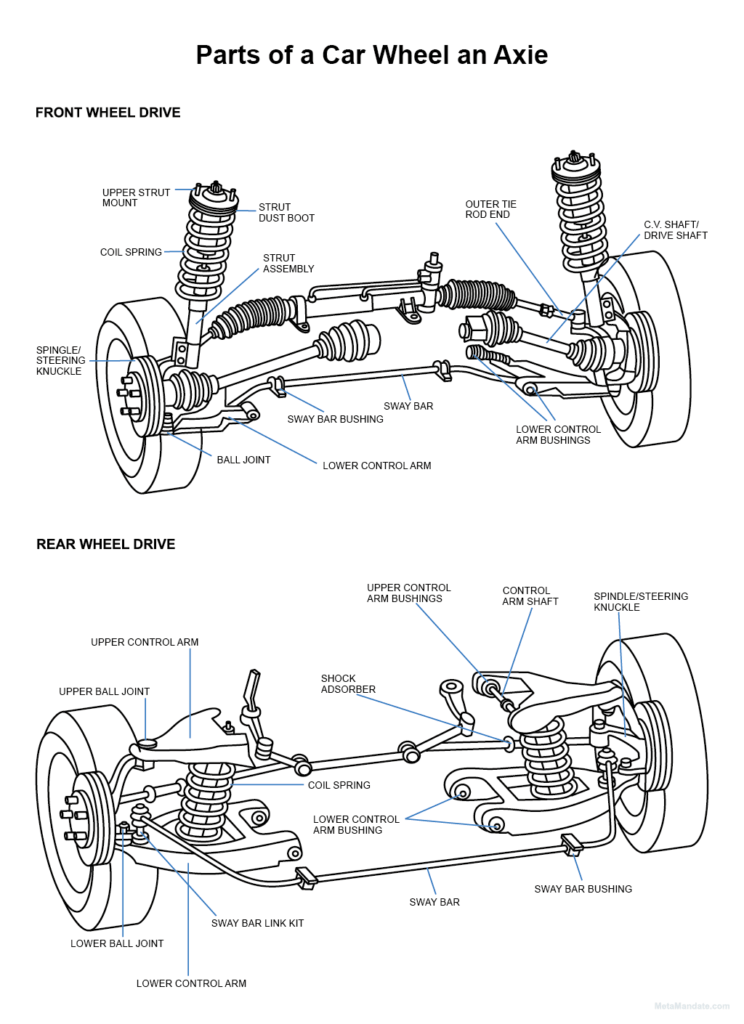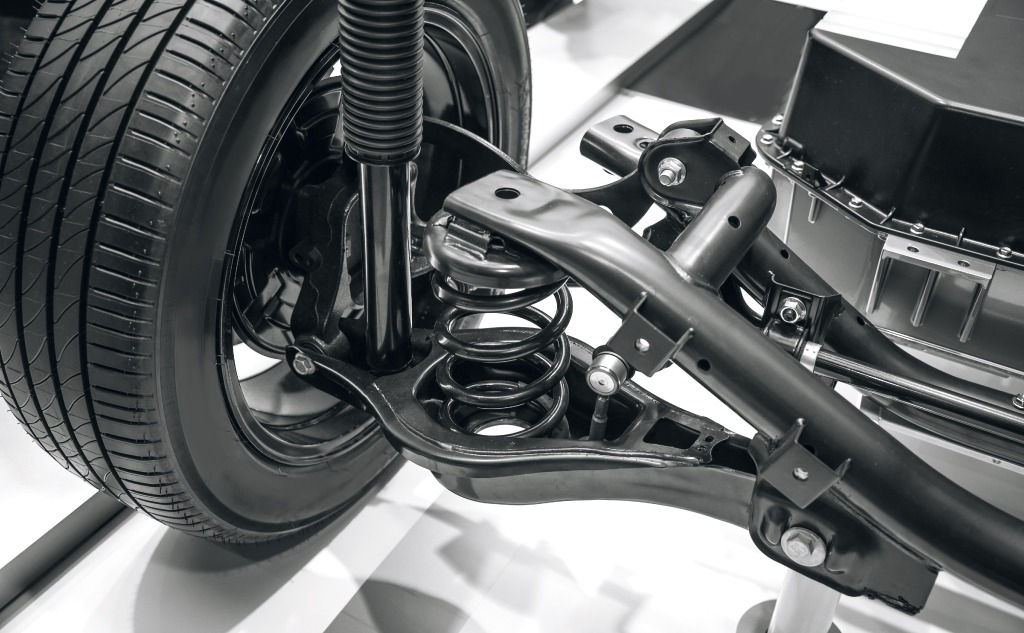Here are the 13 parts of a car wheel and axle:
- Tires
- Rim
- Hub
- Wheel bearings
- Flanges and beads
- Valve system
- Constant velocity joints (CV Joints)
- Axle’s housing
- Differential
- Driveshafts
- Gaskets
- Mounting humps
- Transfer case
So if you want to learn all about the parts of a car wheel and axle, their names, and their functions, then this article is for you.
Keep reading!
Table of Contents
- #1 Tires
- #2 Rim
- #3 Hub
- #4 Wheel Bearings
- #5 Flanges and Beads
- #6 Valve System
- #7 Constant Velocity Joints (CV Joints)
- #8 Axle’s Housing
- #9 Differential
- #10 Driveshafts
- #11 Gaskets
- #12 Mounting Humps
- #13 Transfer Case

#1 Tires
Your tires are the most important part of your car’s wheel—no surprise there. Tires are ring-shaped shells that protect the inner parts of the wheel. They’re usually made of rubber, carbon black, and other synthetic materials.
In addition, tires are the only part of your car that touches the ground. As a result, their main function is to reduce shock. In other words, tires cushion the roughness of bumpy terrains so your car suffers no damage.
#2 Rim
Often people confuse the rim for the wheel. But simply put, the rim is part of the wheel, and the wheel includes the rim. That being said, the rim is the inner piece right after the tire. It’s also typically made of strong metals such as steel.
This is because the rim needs to be able to support the full weight of your car. Rims also have tubeless tubes that link the tires with the hub, where the air is sealed. As a result, the rims’ main function is to ensure the trapped air efficiently fills up the tires.
#3 Hub
The hub is the central part of the wheel. It’s distinguished by the metal studs in the middle. These calipers help connect the hub, and consequently the rest of the wheel, to the car’s axle.
Not only that but, the hub contains brake discs that assist you in stopping the car once you step on the pedal. The hub also has rotors that allow the mechanism of the car to function and move properly.
#4 Wheel Bearings
Wheel bearings are the main part of the hub and are central to the wheel’s essential structure. That’s because they’re the actual connectors between the wheel and the car’s axle. Not just that but, they work directly to carry the car’s load when in drive.
As a result, wheel bearings are constantly subjected to damage. It’s also why they should be tightly screwed into the car’s hub. Otherwise, the road’s elements can easily enter and tear the car’s insides.
#5 Flanges and Beads
The funny-looking edges of your tires are called flanges. Inside them, there are beads. Together, the beads and flanges work to keep your car stable while it treads over different terrains. Flanges and beads do so by adequately transferring the energy of the motor to the wheel.
This is why, if either the flanges or the beads have suffered any damage, the energy won’t be carried correctly. In turn, this will lead to the instability and shaking of your car.
#6 Valve System
From its name, the valve system is the one responsible for monitoring both the inflation and deflation of your tires. This mechanism mainly consists of one of three valve types. You determine which is best according to many factors such as your vehicle’s brand.
In addition, each valve consists mainly of 3 main parts: the core, the cap, and the extension. The core and cap work together to seal the air into the tires. The extension’s function, however, is to help check and adjust the air pressure of your car’s tires.
#7 Constant Velocity Joints (CV Joints)
Similar to your body’s joints, a car’s CV joints help the automobile move its limbs freely. That’s because CV joints connect between the wheels and the car’s transmission. In turn, this allows the tires to fully rotate and move.
CV joints’ other functions include transferring the torque from the transmission to the wheels. These joints also keep the tires running at constant velocity when the vehicle is turning.
#8 Axle’s Housing
As the name suggests, the axle’s housing is where its main components are stored. This is why the housing is typically made of sturdy metals that can withstand any harsh road conditions.
Having said that, the axle’s housing is connected to the rest of the car with axle bearings. Out of them, the center hanger bearing is the most important. That’s because it helps stabilize the axle’s housing while driving.
#9 Differential
The differential is the axle part responsible for maintaining the car’s balance when the front and back wheels are rotating at different speeds.
In addition, a differential consists of multiple gears such as the spider and ring gear. These differential parts ensure proper support between it and both the front and rear axle.
#10 Driveshafts
There are two types of driveshafts: the propeller shaft and the short CV one. Both driveshafts have similar functions but are located in different positions inside the axle’s housing.
To be clear, both driveshafts aim to provide you with a smooth driving experience. They do so by working with the car’s differentials to transfer turning energy to the rear and front axle.
#11 Gaskets
Gaskets are the smallest and most vital part of the axle. That’s because they complete the connection between the car’s transmission, differentials, driveshafts, and the axle’s housing. This way, gaskets are the main reason for ensuring a smooth ride.
Not only that but, gaskets are also responsible for sealing gearbox liquid. They help prevent fluid leakage from happening, which may cause internal damage to the axle’s differential or transmission.
#12 Mounting Humps
Mounting humps are an important part of the wheels. That’s because they play an essential role in ensuring that the tires are safely mounted onto the wheels. This is due to the hump’s slanted shape.
Their design also has ridges. This allows the humps to circle around the barrel of the wheel. In doing so, the mounting humps can separate between the beads and flanges. As a result, the wheels are securely fastened onto the car even when at high-speed.
#13 Transfer Case
The transfer case is part of the car’s axle and is located in the center between the rear and front. The case is also supported by the automobile’s driveshafts and is powered by the vehicle’s transmission.
This axle part’s main function is to alternatively transfer energy back and forth from the rear and front of the car. This ensures a proper balance of power, especially when driving on highways.
